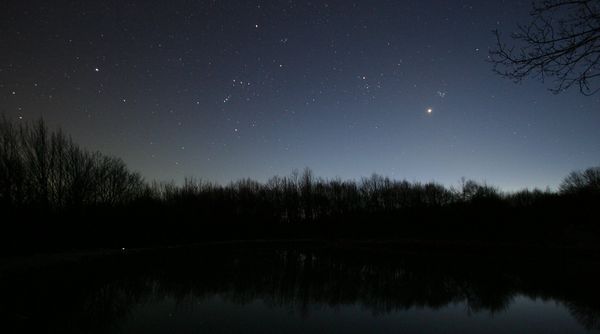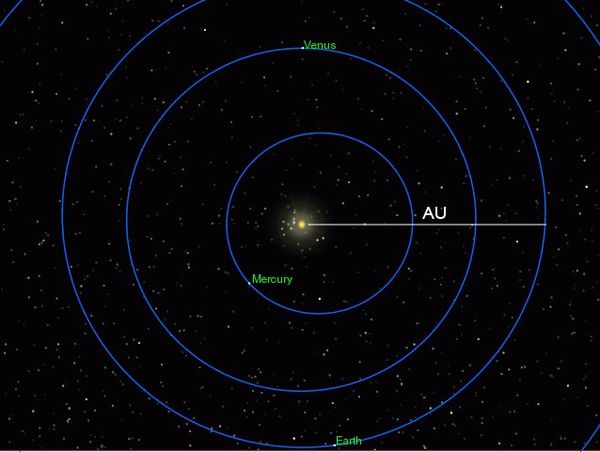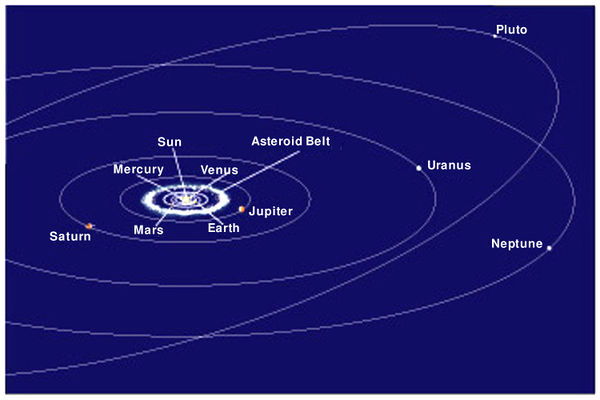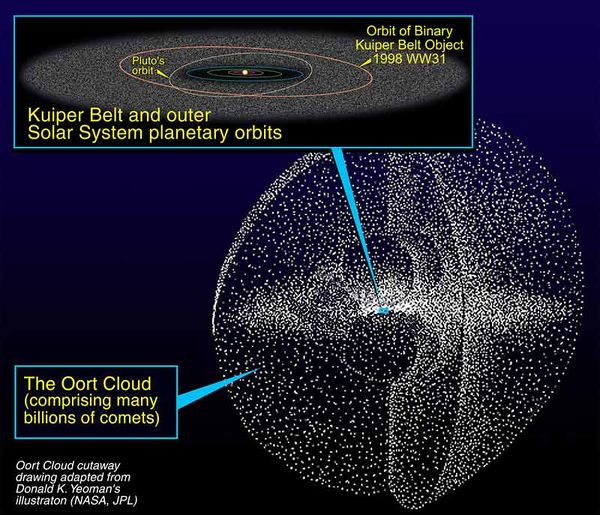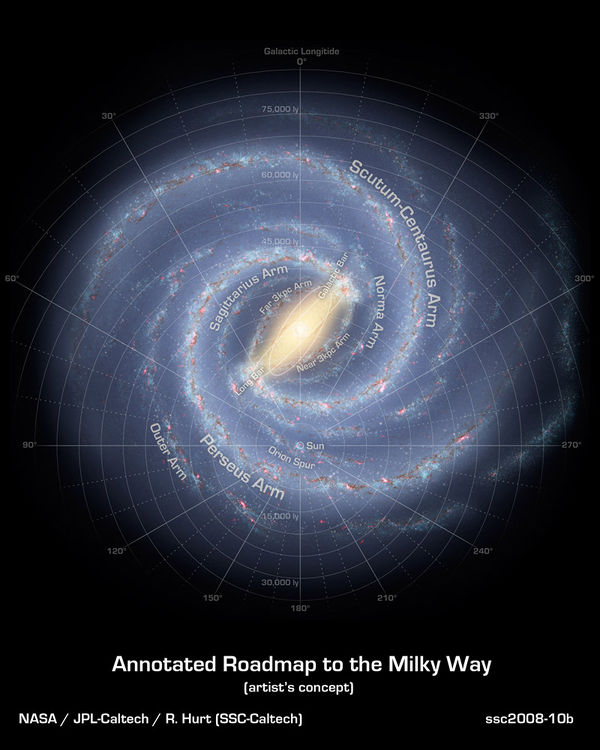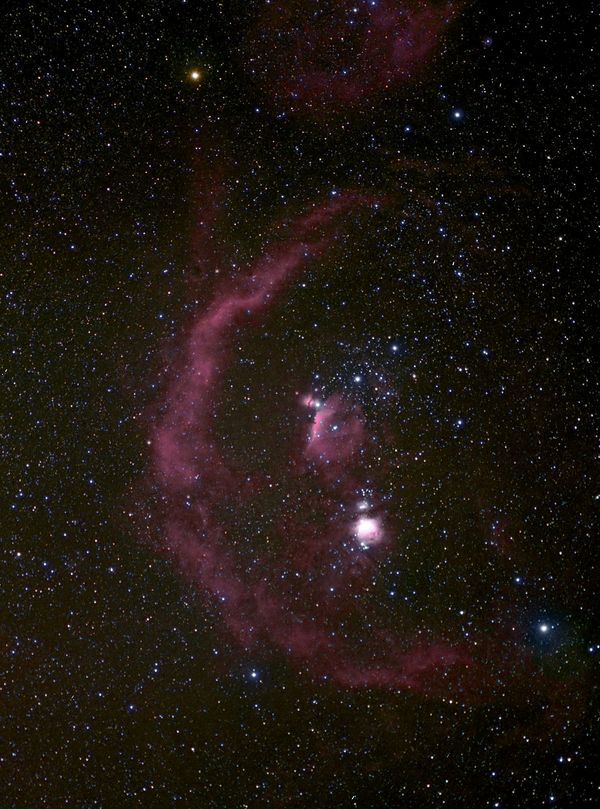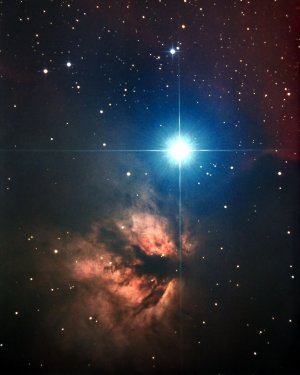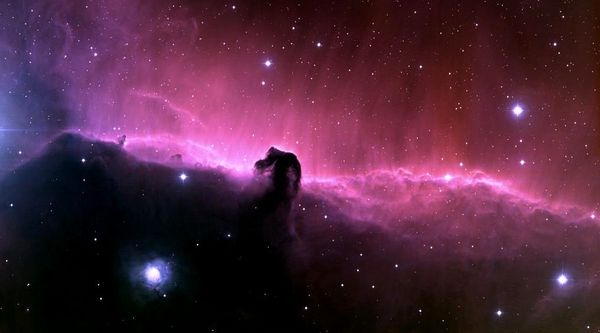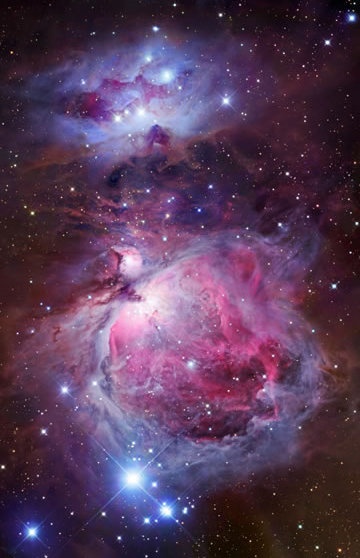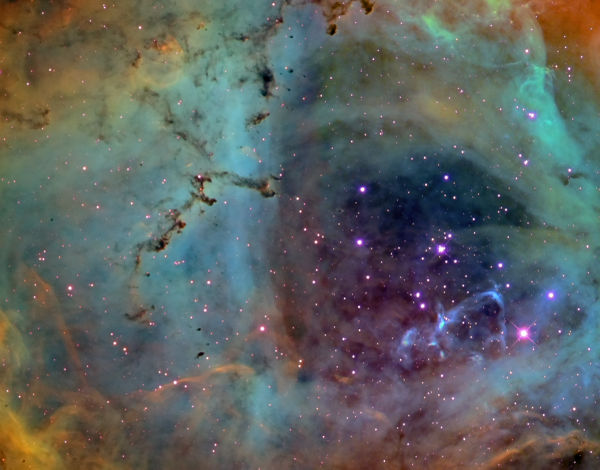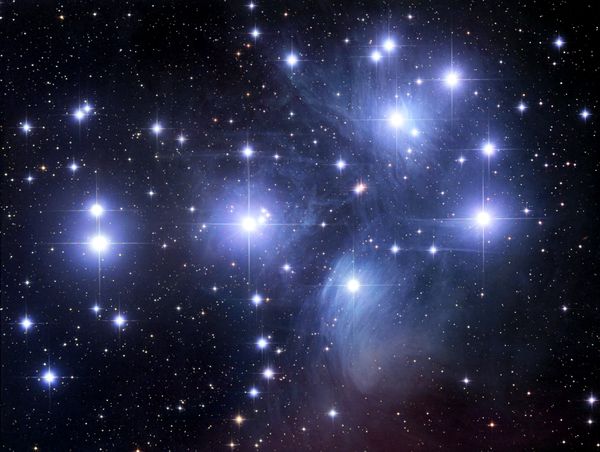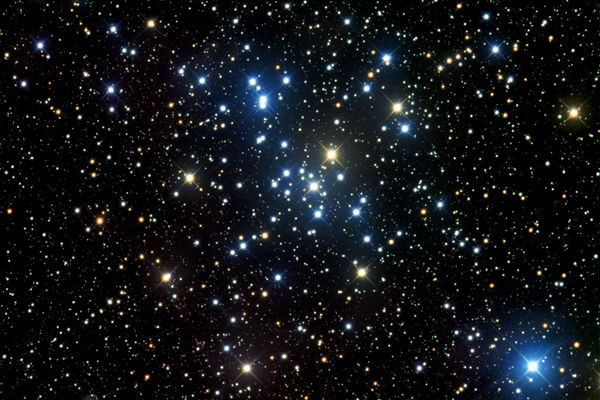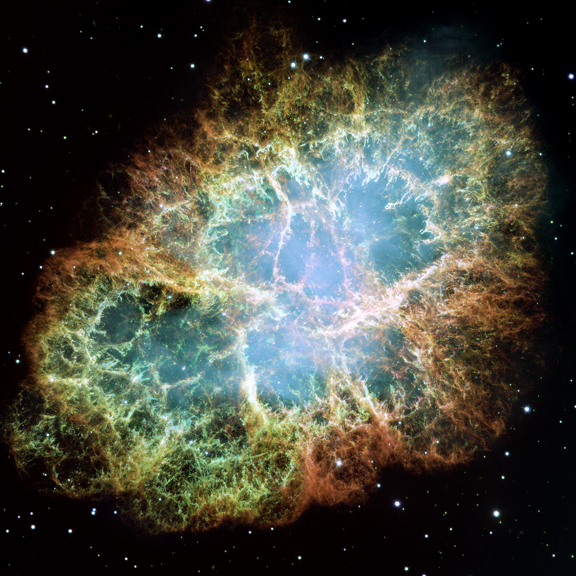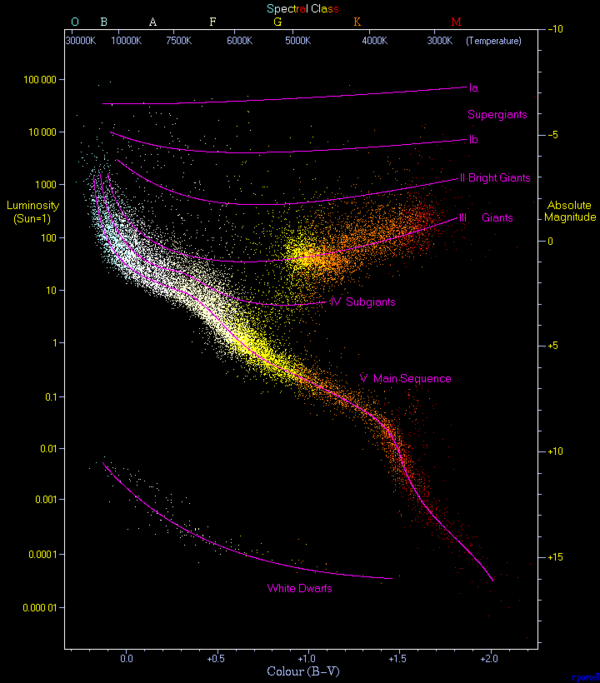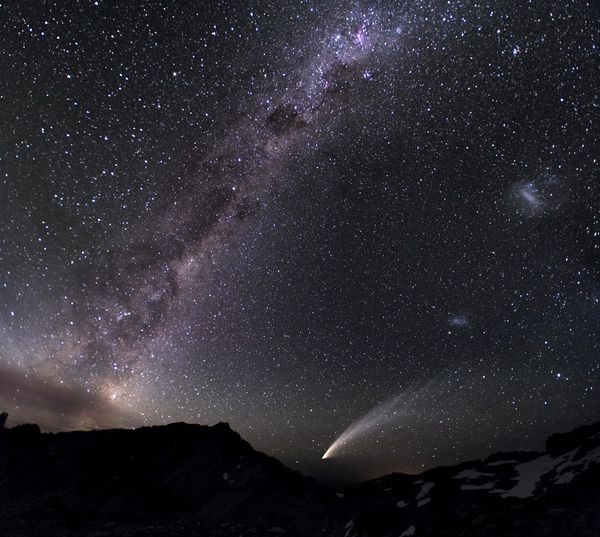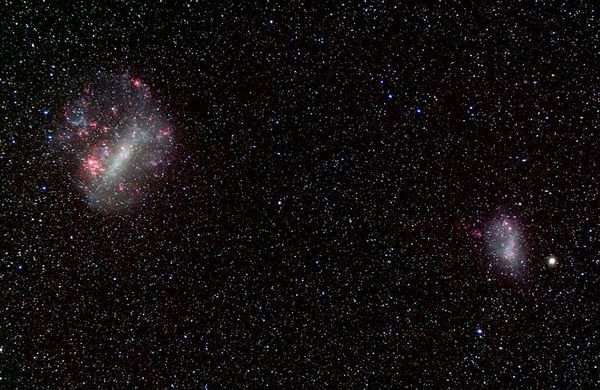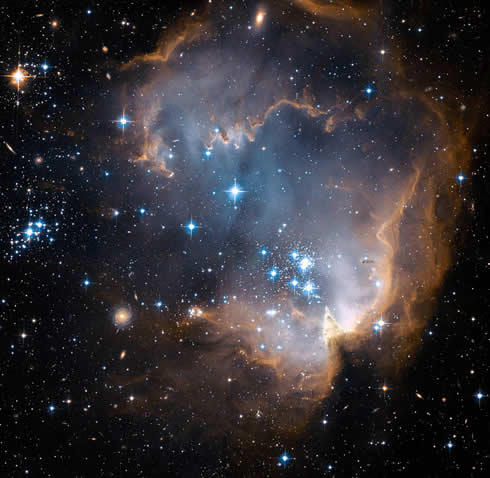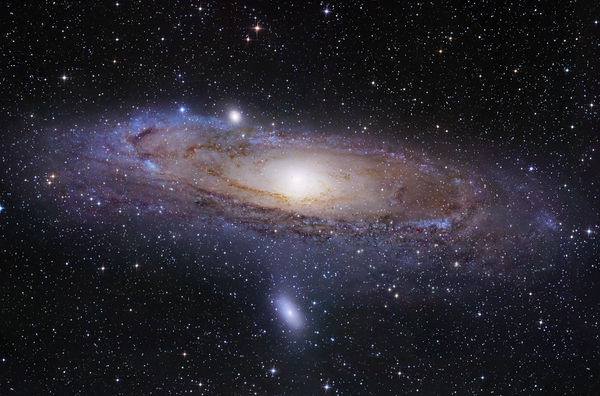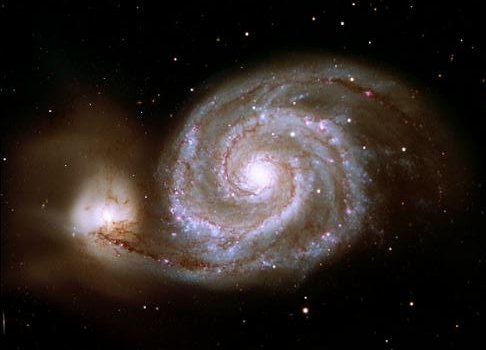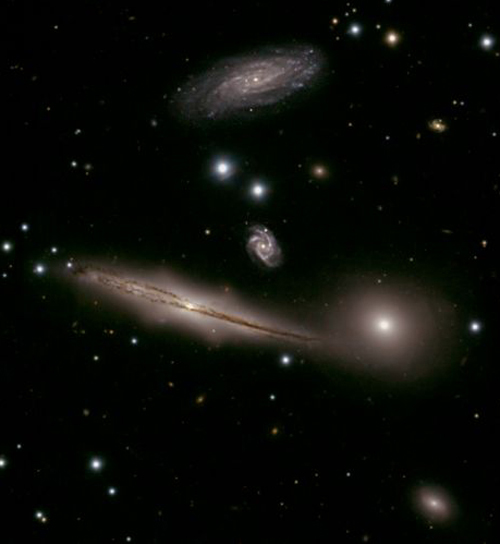We Can See the Universe: Difference between revisions
No edit summary |
No edit summary |
||
| Line 306: | Line 306: | ||
Another famous galaxy is M51, the Whirlpool galaxy, near the tip of Ursa Major's tail, 23 million ly away. | Another famous galaxy is M51, the Whirlpool galaxy, near the tip of Ursa Major's tail, 23 million ly away. | ||
[[File: | [[File:whirlpool_nasa.jpg|600px]] | ||
M51, The Whirlpool Galaxy, is 23 millioin ly away. | M51, The Whirlpool Galaxy, is 23 millioin ly away. | ||
Revision as of 10:55, 20 February 2012
We Can Begin to Understand It
If there's a clear night, look outside this week. Facing south, the sky should look much like the picture below. You can tell it's winter by the winter constellations, Orion (the Hunter,) and Taurus, (the Bull) with the Pleiades on his shoulder, but also Orion's dog Canis Major, who follows Orion across the sky each winter night. The brightest star in our sky is Sirius, on Canis Major's collar.
Where you see zodiac constellations, such as Taurus, the planets, and the light where the Sun is setting, you know you are looking along the ecliptic, across the plane of our Solar System. Venus is the brightest planet nearest the Sun. Sometimes it is the morning "star" and sometimes the evening "star" depending on which side of the Sun it is on.
Canis Major the "Big Dog" (with Sirius in his collar), Orion the "Hunter", Taurus the "Bull", the planet Venus and the Pleiades
As you know, the distance from Earth to the Sun is one (AU) astronomical unit about 150,000,000 km or 8 light minutes.
An astronomical unit (AU) is the distance Sun to Earth
Neptune is 30 AU from the Sun, and takes almost 165 years to complete its orbit. Mercury, close to the Sun at only 0.4 AU, travels around the Sun every 3 months. The distance from the Sun to the Kuiper Belt is about 50 AU. Comets traveling from the Kuiper Belt or nearer, travel for under 200 years. Pluto, once considered a planet, is a Kuiper Belt object. Its orbit, which does not leave the Kuiper Belt, is about 248 Earth years.
The Solar System is mostly open space
Seeing the Kuiper Belt inside the great Oort Cloud makes our solar system seem small
The huge Oort Cloud of debris that surrounds the solar system reaches from 50,000 to 100,000 AU from the Sun. Since 1 light year equals about 63,240 AU the spherical Oort Cloud around our Solar System is about 2 light years (ly) across. Kepler's 3rd Law can give us an idea of the period of these Oort Cloud snowballs.
- P2 = A3
- P2 = (100,000)3
- P2 = 1,000,000,000,000,000
- P = 316,228 years
It may take an object in the Oort Cloud 316,228 years to orbit the Sun. Similarly Comet McNaught is expected to return in about 300,000 years.
All of these things are made up of hydrogen from the Big Bang, elements fused in stars, and compounds mostly formed in the interstellar medium and protoplanetary disks ... wherever conditions of temperature and density of atoms allowed.
We Can See the Milky Way Galaxy
When we see Earth, Venus, Moon (1.3 light seconds away), Sun (8 light minutes away) and comets, we are looking at our Solar System. When we see the stars, we are looking at our galaxy, 100,000 light years across.
The Milky Way galaxy is 100,000 light years (ly) across
Aside from dark matter and dark energy, everything in the galaxy has to do with stars: stars being born, single stars, double stars, star clusters, main sequence stars, stars swelling to become red giants as they near their end, planetary nebula or supernovae of small and large stars as they die, and the white dwarfs, neutron stars, and the black holes they collapse to become. Even the dust between the stars has been within or may become a star.
Our Sun is just one of over 100 billion stars in the Milky Way, and is located about half way out one of the spiral arms. When we see the winter stars, we are looking out, away from the center, across the Perseus arm towards the edge of our Milky Way galaxy.
The Sun is about half way out a Spiral Arm of the Milky Way
When you look at the constellation Orion, this is what you really see. Betelgeuse is an aging red giant star on Orion's shoulder. The left star in Orion's belt is Alnitak, the large hot type-O star we have seen before. Beneath Alnitak is the Horsehead Nebula, gathering dust and gas that may someday create stars. In Orion's dagger we can see the Great Orion Nebula, a starbirth nebula. Its entire light is powered by one extremely hot star. The nebula is about 1350 ly from us. The light you see tonight, left its bright center 660 AD, back in the Dark Ages.
Around the Orion and Horsehead nebulae is the giant Barnard's Loop, which remains from a supernova 2 million years ago. It has spread 300 light years across. Remnants from the Barnard Loop supernova, mixed with debris from other stars and surrounding gases, helped create the nebulae and stars that exist there today. Supernova debris would in that vicinity would have heavy enough elements to create planets, and even life.
Can you find the constellation Orion, the red giant star Betelgeuse, Horsehead Nebula, Great Orion Nebula, and Barnard's Loop curving around the Horsehead and Orion Nebula?
Alnitak and Flame Nebula
Horsehead Nebula beneath the left star in Orion's Belt may someday become a star forming nebula
True Color Orion Nebula, M42, middle star in the "knife" on Orion's Belt
Credit: Robert Gendler
But there are many many many more beautiful nebulae. To the left of Orion, almost the size of the full Moon, but too faint to see by eye, the Rosette Nebula shown below is captured in long exposure photography. It is full of small dark clouds where stars are being born now.
Rosette Nebula
False color Rosette Nebula
Credit:: Hubble Space Telescope
Hydrogen in the Rosette makes it appear magenta in color if you could see it without the aid of an electronic camera. Hubble images are often color coded with emission from sulfur atoms in red, hydrogen atoms in blue, and oxygen atoms in green. Both images reveal dark globules, dust and gas gathering to become stars.
These globules will become single stars like the Sun, binary stars like Sirius in Canis Major, multiple star systems like Polaris, and small open clusters of stars of colorful stars like the Pleiades.
Sirius AB taken by Chandra in x-ray light, compared with Polaris A Ab and B in visible light
Pleiades (Seven Sisters, or Subaru), to the right of Taurus' left horn tip, is an open star cluster that has wisps of a dusty nebula
Credit: Robert Gendler
M41 star cluster in Canis Major (the heart of the "Big Dog")
Credit:: Robert Gendler
The "Double Cluster", NGC 884 and NGC 869, in Perseus
On Orion's shoulder is the red supergiant star Betelgeuse. A dying star that has expanded before its final collapse, it is one of the largest stars known. At 1000 times the Sun's diameter, if it were in our Solar System it would extend beyond Mars and enclose all the terrestrial planets.
Some 5 billion years in the future, the Sun will become a red giant when it nears its end, and expand to enclose Mars as well. Will the Earth be consumed? Perhaps not, because in its last years the Sun will lose enough mass that the Earth's orbit will increase in size. It will not matter for our descendents though. By then the Sun will be so luminous that the icy worlds of the outer solar system will melt, and the Earth's oceans will be evaporated and blown away.
Betelegeuse taken by the Hubble Space Telescope (HST)
When stars like our Sun die, they ultimately collapse to become a white dwarf star, while sending a huge cloud of gas and dust out in a beautiful planetary nebula. Elements up to iron, are fused in stars and sent out in planetary nebulae.
Abell 39
Just to the right of Taurus's left horn tip is the Crab Nebula, M1, about 13 light years across. The Crab nebula is a remnant from a supernova that occurred in 1054. It was recorded by the Chinese, and also by American indians who painted the event under a high ledge in Chaco Canyon, New Mexico.
Supernovae are where heaviest elements, such as gold and platinum and nickel are made in its great shock waves. The gold ring on your finger and the silver in your teeth came originally from a supernova explosion from a giant dying star. Now 13 ly across, in 2 million years it may look like Barnard's Loop and be 300 light years across !
Crab Nebula is about 12 ly across and 6500 ly away
Credit: NASA, ESA, and J. Hester
The Hertzsprung-Russell "HR" Diagram
You can tell the size and how hot stars are by their color.
As previously mentioned, the reddest stars are the smallest and coolest. The bluest stars are the largest and hottest. We may see all the luminosities temperatures and colors of main sequence stars on a Hertzsprung-Russell or HR diagram.
There are, also, dying red giant stars to the upper right, and small deceased white dwarf stars to the lower left. But a spectrum of the star would be needed to keep from confusing it with a main sequence star.
Hertzsprung-Russell diagram. Each dot is a star with a known spectrum or color, and a known magnitude or luminosity. Red stars are on the right. Bright stars are at the top.
Oddly enough the larger, bluer, stars have so much gravity that fusion takes place more rapidly, and they burn themselves out the quickest of all!
Extremely large stars, common in the dense early universe, would only have survived about 3 million years. Whereas the Sun should last more than 10 billion years. The small faint red stars could last thousands of billions of years.
For more precision, each letter in the spectral class or type has 10 subdivisions, from 0 to 9, 0 being the hottest and 9.9 being the coolest subdivision. The hottest (and biggest) stars would be O 0 and the coolest (and smallest) M 9.9. The Sun is G2.
Star Mass (solar masses) Lifetime (years) Spectral Type
60 3 million O3
30 11 million O7
10 32 million B4
3 370 million A5
1.5 3 billion F5
1 10 billion G2 (Sun)
0.1 1000's billions M7
Mass of a Celestial Object
We can tell the mass of a star by its color and spectrum because we understand the processes they use to make the light they emit. But we can also tell mass of celestial bodies, even galaxies, by objects orbiting them.
In Kepler's 3rd Law P2 = A3 (P being the period in years, and A being the semi-major axis in AU) was discovered by watching planets in the Solar System orbit our Sun, a one solar mass star. More generally when a small object orbits something much bigger,
P2 = A3/ M
(M being the total mass in units of the Sun's mass). If we know the period and semi major axis of a system, we can find the mass of that system.
Here's how it works. If M = 2, as around a star of 2 solar masses, the formula becomes P2 = A3 / 2 which means the period squared will be cut in two. If Earth were orbiting a 2 solar mass star, it would have to travel faster to resist the increased gravitational force, and Earth's year would shortened by 1.4 (1.41x1.41 = 2). How long would Earth's year be around a 3 solar mass star if it orbited the same distance it does now around the Sun? In that case P2 = A3 / 3 . ( Hint: 1.73x1.73 = 3). That means the "year" for this Earth would be shortened by 1.73.
Suppose you know the period, the time it takes to orbit a star, and you have been able to measure its semi-major axis, half the distance across the orbit. Using a little algebra, P2 = A3 / M becomes M = A3/P2
Now you can measure the mass of a planet from the motions of its moons, the mass of a star from the motions of its planets or companion stars, or the mass of a black hole from the gases or stars swirling around it.
How to find the Mass of the Milky Way Galaxy
Here's one more, astounding, example. Let's use the orbit of the Sun around as it travels around the Milky Way to find how much mass is "holding" the Sun in its orbit. This is all the matter that is closer to the center of the galaxy than the Sun is. We use Kepler's third law and put in the Sun's distance (25,000 ly or 1.6 billion AU) from the center of the Galaxy, and the time it takes for the Sun to complete one orbit (250 million years) around the Galaxy:
A = 1.6 x 109 AU P = 250 x 106 years
M = A3/P2
M = (1.6 x 109 )3/(250 x 106)2
M = 7x1010 solar masses
The mass of the Milky Way Galaxy, inside the orbit of the Sun, is about 70 billion solar masses. This includes all the stars, the nebulae, and that mysterious dark matter you may have heard about. We will see later that, including stars and matter farther out than we are, the mass of the galaxy is at least 100 billion times the mass of the Sun!
(In case you want to know: The distance to the center of the Milky Way is found by measuring the globular clusters that surround its center and taking the average distance to the center of their distribution. The time to orbit the galaxy is known from the speed of the Sun measured by redshifts to surrounding galaxies, and dividing it into the circumference of its orbit, which is simply C=2πR, where R is nearly A.)
Other Galaxies Near and Far
Our galaxy is 100,000 ly across. Beyond our galaxy are other galaxies, all with colorful stars, starbirth nebulae, star clusters, aging red giants, stars dying in planetary nebulae, and supernova remnants. The nearest companion galaxies are the Large and Small Magellanic Clouds, 160,000 and 200,000 light years away respectively.
Milky Way with Large and Small Magellanic Clouds to the right as seen from the southern hemisphere. Comet McNaught is to the lower right. The comet is in our solar system. The stars are in our galaxy. The Large and Small Magellanic Clouds are nearby galaxies outside our Milky Way galaxy, about 160,000 and 200,000 ly away respectively.
The Large Magellanic Cloud is the fourth largest galaxy in our Local Group of galaxies. It appears to be irregular in shape, with a bar of old red stars.
Large and Small Magellanic Clouds
All galaxies contain stars and star clusters. Galaxies where stars are still being formed have beautiful starbirth nebulae like this one in the Small Magellanic cloud,
Starbirth nebula in the Small Magellanic Cloud
and Supernova remnants like this one in the Large Magelanic Cloud.
Supernova remnant in the Large Magellanic Cloud
The first, second, and third largest galaxies in our Local Group are our Milky Way, the Andromeda galaxy, and the Triangulum galaxy, all of which are spiral galaxies with black holes at their centers.
M31, The Andromeda Galaxy, 2 million ly away, is the sister galaxy to and resembles the Milky Way. Notice its smaller companions.
Another famous galaxy is M51, the Whirlpool galaxy, near the tip of Ursa Major's tail, 23 million ly away.
M51, The Whirlpool Galaxy, is 23 millioin ly away.
And beyond them are billions of other galaxies and clusters of galaxies.
Hickson Galaxy Group
And still further away we see gamma ray bursts from giant stars exploding in the early Universe, and quasars where black holes are gobbling mass in the centers of young galaxies. Since the light we see from galaxies 10 billion light years away has taken 10 billion years to reach us, that means we are seeing galaxies as they appeared 10 billion years ago. In these images you are looking back in time 10 billion years!
Galaxies billions of light years away in the Hubble Deep Field image
Even further away there are more galaxies.
Galaxies 14 billion light years away, as seen in Hubble's Ultra Deep Field
There were hundreds of bright galaxies forming 14 billion years ago, 900 million years after the Big Bang. BUT researchers looking further into the past, 700 million years after the Big Bang found only one. Something must have happened to create the brighter galaxies that did not exist in earlier times.
It has been 400 years since Galileo first turned his telescope to the sky and saw Jupiter's moons.
Jupiter and its moons as Galileo may have seen it.
In 1610. Galileo used his telescope and logic to expand our view of the cosmos by demonstrating that the Earth was not at the center of the Universe. When he viewed these satellites, he saw them as they were 30 minutes earlier, the time it takes for light from Jupiter to reach us. Today we look back 14 billion years, using the largest telescopes in space and on Earth, giving us a window to the very beginning of time itself.
